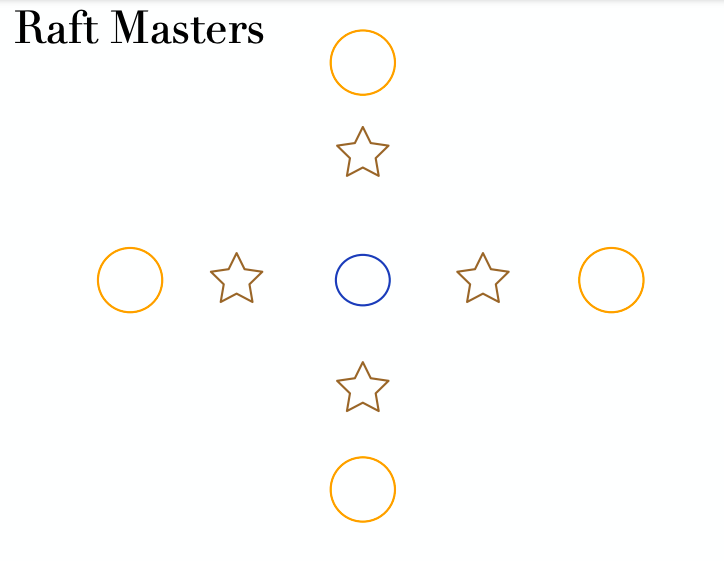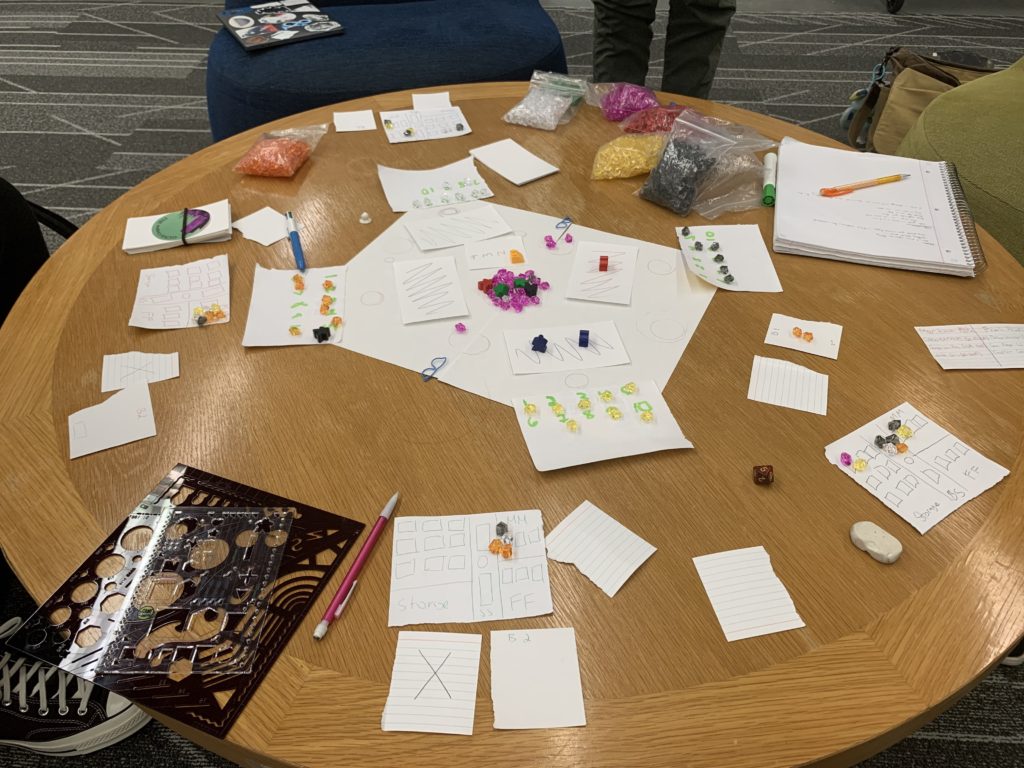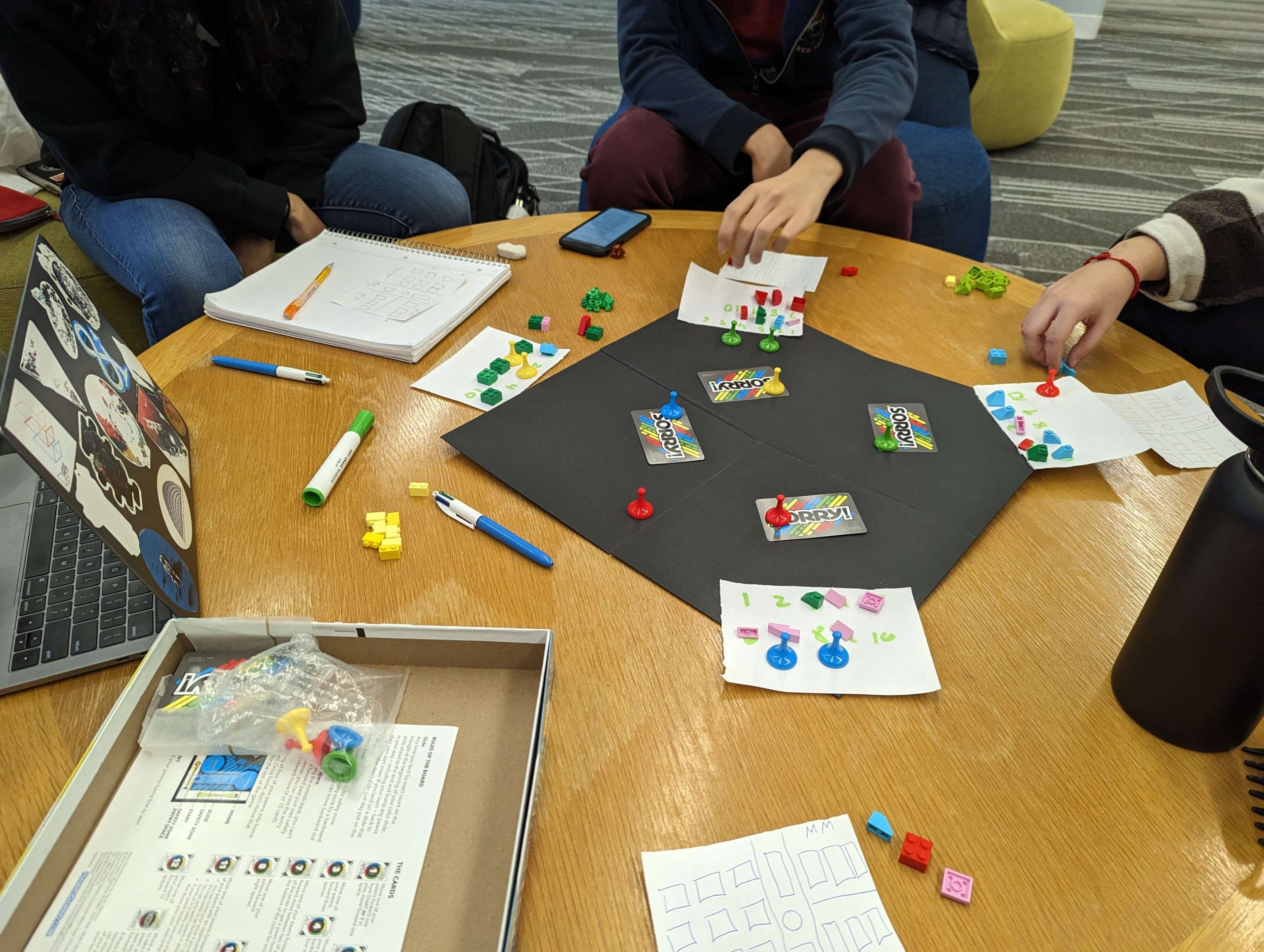
One problem our group never expected during this project was to have too many ideas to work with. Throughout the prototyping process, we have come up with quite a few but were in total able to play through three different concepts, each with their own different mechanics and themes. For this process post, we will be discussing two of our concepts that we were able to play around and make changes to, but in the end ultimately decided to not commit as our final project: Raft Masters and Titans of Catan.
Scheduling
Very quickly, we’ll go over our scheduling process. As soon as our teams were assigned, our team immediately got to work. Within the first week, we had met twice and spent upwards of 5 hours playing Catan and King of Tokyo together. Towards the end of our second meeting, we were already breaking down our experiences within each board game and establishing our own pillars that we felt would be fun for us to incorporate into our final project. By the third meeting, we were already prototyping and playtesting Raft Masters, which served as our first game we tried, and by next week on our fourth meeting we prototypes and tested Titans of Catan and Paid in Paradox, the final board game we decided on and will discuss in our second process post.
The Collaborative Process
One important point of our collaborative process was found in our effective communication. Once we broke into groups, we were all quick to share our schedules and make time to hangout and start on the project as soon as we could. For example in our first meeting, although we ended up playing board games, we also gelled really well as a design team. It seems like a small detail, but playing board games together helped as a way to get to know another, causing our team to feel comfortable around one another and making it a safe space where all ideas were encouraged and supported. This also meant that there was a place for constructive criticism among the group, which helped us pinpoint areas of our prototypes that needed improvement.
Raft Masters

Raft Masters, created by Izzy Martino, was the first idea introduced to the group and the first one we started to prototype. Raft Masters is a competitive, four-player game consisting of some islands, two stranded crew members, some rotating rafts, and a looming storm.
The initial goal of the game was to be the first to collect all the resources necessary to fully upgrade your raft with your crew members on board. Resources would be collected by making your crewmembers swim to other islands and return to the ship to craft the necessary items. The other win condition would require all other crew members to die, be it from drowning from the storm or being killed by other players.
In the first week, Raft Masters went through multiple changes by the team from its initial design. Changes included when the storm hit, the rotating raft mechanic, trading interactions, and resource management. However, with this being our first time prototyping as a team and just our first concept, we decided to test our other game options before further development. We’ll explain challenges we had later in the Challenges section of this post.
Titans of Catan
Titans of Catan, created by Noor Amin, was the third concept we tested and played around with near the end of the second week. Inspired by the economic and contractual language in Settlers of Catan, this game engaged players in a narrative around climate change and urban planning, for which they assume the roles of four “Titans” attempting to sway public opinion in their favor. For instance, the Environment Titan represents an environmental resource government agency, while the Financial Titan represents Big Oil. As the game progresses, players must adapt to physical changes to the board that limit their ability to acquire resources.
Two components supported the game’s procedural rhetoric: development cards and alliances. Firstly, unique development cards enabled players to enact physical changes to the board. The most common of these cards, City Building, allowed players to remove one hexagon on which they own settlements and place it elsewhere, including on top of other hexagons. When hexagons are stacked, only the topmost hexagon is at play, though other players may unstack other hexagons to retrieve their settlements. The alliances mechanic formalizes the lasting interpersonal relationships that emerged between pairs of players during our Settlers of Catan playthrough. Two players may ally with each other once per game, for which specific pairings unlock buffs. For example, when the Financial and Technology Titans form an alliance, they unlock the Security Breach buff, in which other players must reveal their cards to the allied pair on demand. However, once an alliance is broken, the pair must combine their decks and split their resources evenly.
Despite its numerous opportunities for sabotage, Titans of Catan is fundamentally a cooperative game: all players may win if they discover the symbiotic relationships that prevent the destruction of land for resources. However, our playtest revealed significant challenges with balancing, such that players found destroying other players’ settlements less risky and more viscerally rewarding than forming alliances. Hence, we remained stuck at the game’s starting conditions: when one player placed a settlement, another player destroyed it in the next round. This failure proved to be generative, as players understood how their actions mirrored real-world issues in urban planning. Moreover, Titans of Catan remains as the only board game we’ve played as a group that explores verticality and opened up discussions about player personas, which re-emerged in our final game.
Challenges
We thankfully didn’t face any major challenges during our scheduling or collaboration. If anything, our biggest challenge was simply deciding which game to choose as our final project. By using the wise words of “failing faster”, the best way we started to make changes and improvements in all our prototypes was by simply play-testing until we came across a problem. Some issues were small and resolved on-the-spot, allowing us to continue playing. However, there were some instances where to figure out the solution for a large problem, we would need to completely reset and start-over.
For Raft Masters, the main reason we decided not to choose it for our final was because of its complex rules and our belief that with the given time we had left, we wouldn’t be able to finish it fully. Raft Masters, in our opinion, holds a lot of long-game potential that could really cut things down to the wire. However, due to its scale, we wanted to give it the time it deserved, so we threw it on the backburner to revisit later.
As for Titans of Catan, we were worried that this premise sounded more as a mod of Catan than an original concept. Although extremely fun to play and holding a lot of potential, it didn’t deviate enough to consider it a separate game altogether. In the end, we decided Paid in Paradox would be the best option. (You can read more about Paid in Paradox in our next post).
Accomplishments
Probably our biggest accomplishment is the fact that we were able to come up with three solid game ideas. Although we had to choose only one to fully commit and work on, we hope to one day come back and perhaps complete Raft Masters and Titans of Catan. With the experience we gained from working on all our prototypes, we are excited to see what kinds of new discoveries and progresses we can make as we now fully shift focus to Paid in Paradox and deliver a final product that we are all proud of.
